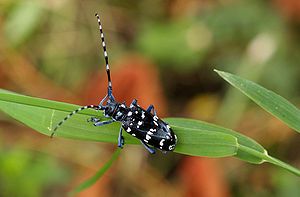Citrus longhorn beetle
| Citrus longhorn beetle | ||||||||||||
|---|---|---|---|---|---|---|---|---|---|---|---|---|

Longhorn beetle ( Anoplophora chinensis ) |
||||||||||||
| Systematics | ||||||||||||
|
||||||||||||
| Scientific name | ||||||||||||
| Anoplophora chinensis | ||||||||||||
| (Forster) , 1771 |
The citrus longhorn beetle ( Anoplophora chinensis , also Chinese hardwood beetle , sometimes abbreviated CLB ) is a beetle that is native to various countries in Asia . There it attacks about 100 different deciduous trees, mainly citrus plants . It is considered a tree pest , infested trees are severely damaged or die.
distribution
The citrus longhorn beetle is found mainly in China , Korea and Japan . It is also found in Taiwan , Indonesia , Malaysia , Myanmar , Vietnam, and the Philippines .
A. chinensis reaches outside of its main distribution area mainly through plant exports. In individual cases the beetle has managed to spread as a neozoon . In Europe, the first outdoor infestations were registered in Italy in 1997 and in France in 2003 . The French source of infection is considered to be eradicated. The citrus longhorn beetle was detected in imported plant consignments from Asia in several EU member states and Switzerland , and after 2004 in Germany also individual specimens outdoors. Finds were registered in Hesse in mid-2009 and near Munich in 2014 .
In 2011, the Julius Kühn Institute asked the population to pay attention and report any beetle finds.
In the United States , there was an open field infestation in Washington state in 2001 . The hearth is also considered to be exterminated. Individual beetles have been found in Georgia and Wisconsin .
In the European Community and Switzerland, there is an obligation to report infested trees and beetles found. The report should be sent to the responsible plant protection departments. The citrus longhorn beetle is a so-called quarantine pathogen .
biology
The citrus longhorn beetle is glossy black with irregular light spots on the wings , it grows to about 21 to 37 mm, the male slightly larger than the female. The antennae are long - about twice the length of the body in the male - and striped with black and light blue. The pronotum has two light spots. The larvae are legless and white to cream-colored, up to 60 mm long and 10 mm thick. The prothorax has a brownish mark. The egg resembles a grain of rice. It is 5–6 mm long and creamy white. Before hatching, it takes on a yellowish-brown color.
The life cycle of a beetle is between 12 and 24 months. The beetles hatch from April to August, in Italy from early June to August. The beetles bore their way out of above-ground or near-surface roots, root approaches and the base of the trunk of the infested tree. Shortly afterwards, they start eating leaves, petioles and the bark of branches. The beetles live up to two months and are mainly diurnal. About ten days after hatching, the female lays up to 200 eggs after fertilization. For this purpose, it cuts T-shaped slits or small funnels into the bark of roots, aboveground roots and the base of the trunk with the mouthparts . An egg is placed in each of these. Temperatures below 20 ° C reduce the number of eggs laid.
The approximately 5 mm large young larvae hatch within one to three weeks and first eat in the phloem under the bark. Then irregular larval ducts that are around 1.5-2 cm in diameter are eaten into the root wood. The corridors go deep into the wood, they lead to an interruption in the flow of sap and a reduction in the strength of the wood. After a development time of about one to two years (depending on weather conditions) pupate the larva within the roots or buttresses. The pupal stage lasts four to six weeks. When the beetle hatches, a new life cycle begins.
Delimitations
The A. malasiaca and A. chinensis formerly regarded as independent species were combined into one species in 2002, but can be differentiated molecular-biologically . While the Asian longhorn beetle ( A. glabripennis ) only closely resembles the citrus longhorn beetle, the egg, larva and pupa of the two species are so similar that they can only be distinguished by molecular biology .
swell
- Eradication program ( memento of July 15, 2010 in the Internet Archive ) in Lombardy
Individual evidence
- ↑ Neue Westfälische of July 3, 2008
- ↑ GABOT.de
- ^ Süddeutsche Zeitung: Compulsory controls in the garden , October 7, 2014 , accessed on October 15, 2014
- ↑ gartenfreunde.de: On the wanted list: Citrus longhorn beetle
- ↑ Julius Kühn Institute : Information on Anoplophora chinensis (longhorn beetle) ( Memento from July 21, 2019 in the Internet Archive )
- ↑ Steven W. Lingafelter and E. Richard Hoebeke: Revision of Anoplophora (Coleoptera: Cerambycidae). 236 pp., Entomological Society of Washington, Washington, DC. 2002, ISBN 0-9720714-1-5
Web links
- Invasive hardwood longhorn beetles from Asia. Ecology and management . WSL information sheet for practice - PDF (3.1 MB)
- EU decision on urgent measures to protect the community against the introduction and spread of Anoplophora chinensis (Forster) on the website of the Julius Kühn Institute (PDF, 61 kB)
- Distribution and further information at gbif.org